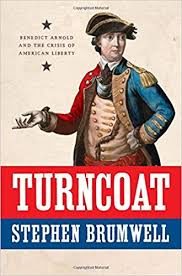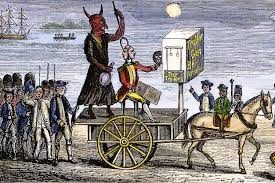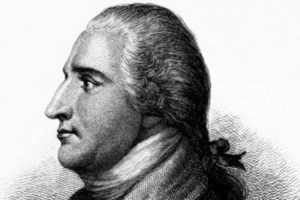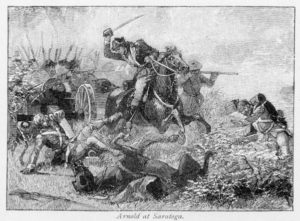Benedict Arnold has fascinated Americans for two centuries. One of the Continental Army’s most accomplished generals defected to the British Army for money and revenge. He oversaw military operations in Virginia during 1781 and turned over command to Lord Cornwallis when Cornwallis reached Yorktown. Arnold departed the scene to avoid any proximity to Gen. George Washington, who wanted him caught alive and hanged for treason. Historian Stephen Brumwell’s new research into Arnold’s life has yielded the latest study of America’s most famous traitor. Turncoat: Benedict Arnold and the Crisis of American Liberty provides a fresh perspective on Arnold’s personality and his sense of honor. In this excerpt, Brumwell examines the extent of Peggy Shippen Arnold’s influence on her husband’s decision to change sides.
— Courtesy of the Museum of the American Revolution, Philadelphia
 In assessing the motivations behind Benedict Arnold’s treason, a final factor must be considered. How far did his young wife influence his actions? The timing is highly suggestive. Arnold was married on April 8, 1779. Within a month he had contacted Joseph Stansbury to offer his services to Sir Henry Clinton. It’s tempting to see Peggy Arnold as a catalyst. She encouraged her besotted and conflicted husband to turn to the British. Or even originating the treason herself.
In assessing the motivations behind Benedict Arnold’s treason, a final factor must be considered. How far did his young wife influence his actions? The timing is highly suggestive. Arnold was married on April 8, 1779. Within a month he had contacted Joseph Stansbury to offer his services to Sir Henry Clinton. It’s tempting to see Peggy Arnold as a catalyst. She encouraged her besotted and conflicted husband to turn to the British. Or even originating the treason herself.
Authorities didn’t openly accuse Peggy Arnold of complicity in the plot during her lifetime. But her friendship with British officers like John André gave grounds for gossip. When he visited Philadelphia in December 1780, the chevalier de Chastellux was invited to drink tea at a house. Chastellux observed of Nancy Shippin:
“Thus we see in America the crimes of individuals do not reflect upon their family. Not only had Dr. Shippen’s brother given his daughter to the traitor Arnold a short time before his desertion. But it is generally believed that being himself a Tory, he had inspired his daughter with the same sentiments.”
 Congressman Charles Thomson had already wondered about Peggy Arnold’s hold over a man who was “brave but avaricious, fond of parade, and not very scrupulous about the means of acquiring money to defray the expenses of it.” While unconvinced of Peggy’s involvement in the plot itself, Thomson’s suspicions were aroused by her “Tory” connections. As reported in the Pennsylvania Packet, Peggy had received correspondence from John André after the British departed Philadelphia for New York; whether there was a more sinister purpose to the letter, written “under pretense of supplying her with millinery,” Thomson could not say, and its true significance was not revealed at that time.
Congressman Charles Thomson had already wondered about Peggy Arnold’s hold over a man who was “brave but avaricious, fond of parade, and not very scrupulous about the means of acquiring money to defray the expenses of it.” While unconvinced of Peggy’s involvement in the plot itself, Thomson’s suspicions were aroused by her “Tory” connections. As reported in the Pennsylvania Packet, Peggy had received correspondence from John André after the British departed Philadelphia for New York; whether there was a more sinister purpose to the letter, written “under pretense of supplying her with millinery,” Thomson could not say, and its true significance was not revealed at that time.
For a century and a half after Arnold’s defection, historians were virtually unanimous in absolving his wife of any deliberate part in his despicable crime, while also recognizing that her sympathies and social network played some role in turning him toward the British. For example, Jared Sparks considered that Arnold’s marriage “probably had a large share among the original causes” of his defection. Besides his wife’s “biases” toward such British officers as Captain André, the “alliance” brought Arnold into “perpetual contact with persons who had no sympathy with the friends of liberty… but who, on the contrary, condemned their acts, and secretly hoped that the power of the British King would crush all opposition and again predominate.” But for all that, Sparks stopped short of actually accusing Peggy herself, believing that, despite her influence on her husband, she remained oblivious to his treasonable correspondence.
 For Peggy’s contemporaries, the prevailing belief that she was entirely innocent of treason was largely a consequence of her youthful beauty and engaging personality, which played on both the lustful and the chivalrous instincts of susceptible males of all ages. But it also reflected ingrained patriarchal attitudes toward women of Peggy Shippen’s refined background. These well-meaning but patronizing views also influenced the opinions of many nineteenth- and early twentieth-century historians.
For Peggy’s contemporaries, the prevailing belief that she was entirely innocent of treason was largely a consequence of her youthful beauty and engaging personality, which played on both the lustful and the chivalrous instincts of susceptible males of all ages. But it also reflected ingrained patriarchal attitudes toward women of Peggy Shippen’s refined background. These well-meaning but patronizing views also influenced the opinions of many nineteenth- and early twentieth-century historians.
There remains no conclusive proof that Peggy Arnold persuaded her husband to change sides. And still less that she originated his treason. She not only knew of his designs. Her participation was first uncovered in 1941. Carl Van Doren published papers from the headquarters of Sir Henry Clinton. They included André’s careful record of his interview with Stansbury. In response to a query raised during their conversation, the captain was frank.
After apologizing to Miss Chew for failing to forward drawings of the head-dresses fashionable in New York, André casually inserted the crucial sentence:




